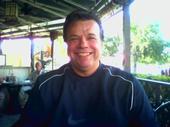When a new idea comes into play people don’t always take to it. Change is difficult and sometimes the hardest change is enacted only through necessity. Interviewing Ken Howard was one of those times I realised how backward we are in some ways. We still use some of the most outdated technology in our work. It takes vision to know the way to go. Read my conversation with Ken and you may well see that future paths are already envisioned– Ken wants to share his vision with you all…
Q) Hi, Ken, great to meet you! So tell me all about yourself.
A) I was born on July 9, 1958, the youngest of three brothers in Northern Virginia. I spent many a beautiful summer weekend camping in Ocean City, Maryland and whiling away time fishing on the banks of the Potomac in Patuxent River. I went to a private school and then I graduated from a college prep school in beautiful Breton Bay, Maryland– oh boy, back in 1976. Upon graduating in 1976, I attended a four year mechanical course at a union school and I achieved proficiency in math and sciences. Then in 1981, I graduated and landed on my feet working in the field of refrigeration, air conditioning, mechanical engineering, and hydronic systems.
I guess being the youngest brother I was always told, “You can’t do that,” and I always answered back, “Yes, I can.”
Q) Would you say that a “yes, I can” attitude has helped you achieve through your life?
A) Yes, very much so. The attitude “yes, I can” has been my modus operandi because I was always told that I couldn’t do it and I always proved them wrong in the end. I always strove to show them that I could do it and I often amazed many of my peers and my family members. I don’t let anything get in my way and I do not take no for an answer. I always think outside the box.
Q) Tell me about some challenges you faced and how you dealt with them?
A) I’ve always been a mover and a shaker in my industry of heating and air conditioning. I’m always looking to achieve alternative or sustainable methods; always looking for a better way to do things and change conventions, so I have always been challenged. However, the biggest challenge I ever had to overcome when I was about thirty years old. I had always wanted to go to Australia to live and work there and I made that dream come true in 1990.
I was in Washington, DC and found the Sydney Morning Herald newspaper to look for jobs. After spending approximately $800 faxing my resume, I found several companies that were more than glad to hire me and one wanted me, in particular. The company was called Complete Engineering and was based out of Sydney, Australia. I was extremely delighted with them; but even more so when they sponsored me into the country.
Q) Why did you choose Australia? What made Australia the obvious choice for you?
A) I love the people of Australia. I love the country, I love the work ethic there, I love everything about that country. Although it was quite an adventure, my gut did get homesick. Being the baby and the youngest, I got homesick after a while and came back to the States.
I actually think one of the next biggest challenges that I faced was probably a short time after I got back from Australia– maybe about six months or year later– I got the urge to travel and I got a job in Panama. I got my Bachelor’s degree in mechanical engineering, and refrigeration & air-conditioning, and hydronic systems– building automation systems. The area I really like is sustainable energy and sustainable infrastructure.
Q) That is the subject of your latest book, correct? Sustainable energy and infrastructure?
A) Yes, that is correct, Nick.
Q) What is sustainable energy and infrastructure?
A) Well, that’s a great question! Here we are in the 21st-century, two decades past 1990, and we are using global positioning systems and satellites and we are talking at the speed of light, literally, through fiber-optic cables; yet were traveling on 150-year old roads. Why is that?
Sustainable infrastructure is infrastructure that has zero carbon footprint. We can build better energy systems and we can build better transportation systems that are much faster. It’s the future.
Q) Your book is basically a blueprint for the evolution of our technology, then?
A) Yes, exactly right. It’s evolution. That is a great way of describing it. The Cro-Magnon man, for example, was inferior to the Neanderthal; but the Neanderthal did not have the brainpower of the Cro-Magnon man. The Cro-Magnon man with his technology moved on and progressed and that’s what we must do. We have the technology to do it. This is a vision that is within our grasp.
Q) So would you say it’s true that the world we live in is rather “Neanderthal” compared to what it could be?
A) Yeah, we are flying around in airplanes that are constantly delayed from weather and all types of other reasons. It costs tremendously more to do so than if we were using the technology that is already out there and ready to use.
Q) In your new book, Internomics: The Lateral Collective Interface, you explain how we can modernise the world. Where do we start?
A) There is a technology that Westinghouse has already developed and is already in use in a dozen locations worldwide. It basically takes our garbage landfills and converts that garbage into energy. That is the way of the future, Nick!
This technology is called plasma enhanced metal and basically it uses the fourth state of matter which is a plasma field. Plasma is the forestay to matter; any material you put through it gets broken down to the atomic level and can be reconfigured into any other useful material that we need.
It’s estimated that we have 4000 landfills across the country and every one of these landfills could be converted. We could supply 100% of overall fuel needs, electrical needs, and many material resource needs from these landfills. This is the kind of evolution my book explains. The evolution that will allow us to move in new and exciting directions.
Q) This is fascinating, but I have one big question. Why haven’t our governments bought into this new idea?
A) It’s the same old song and dance, Nick. The powers that currently exist do not like change. No one likes change, they resist change. It’s like Gandhi once said, “The first day they ridicule, and then that make fun of it, then they attack it, and then they accept.” The four stages that people go through when they resist.
Additionally, you have to realize that the current infrastructure that’s in place right now is the hydrocarbon society is basically saying, “I have a deal set up with the government. We are making money and we won’t turn our backs on that.” Change takes time, I am afraid, Nick.
Q) Have you discussed this at any length with any politicians? It would be interesting to hear their excuses.
A) No, I have not tried to speak to politicians about this. I just to wrote the book to get the idea out there. The book tells it pretty much as it is and I think it can do well. If the people want the technology then they will have it. It is my plan to make sure the facts are known and out there.
Q) Your focus is to educate people about the possibilities? That’s all?
A) No. Not what can be. I am telling them what already exists. These technologies already exist in plants that are working worldwide right now and they are profitable. They have made money from day one; they do not need subsidies. These technologies that I speak about in the book are real and it’s not what we could be doing, it’s what we already have. I just want us to do it!
Q) What do you hope to achieve with your book? Do you think you can get this out there and make an impact?
A) I hope to educate people that this technology exists right now. It is off-the-shelf ready to go. Companies are ready and all we need to do is have the political will and the people to get behind it and get their Congressmen and Senators and tell them that this is a way for America to be number one.
Q) Well, I’m impressed! The world will be a different place when all this happens. Where can people get Internomics:The Lateral Collective Interface?
A) The paperback book is available online at Amazon.com. It is also available on my website. The e-book will be available in about one week. I’m doing all this myself– I built the website and designed the cover jacket, too!
Q) Are you embarking on a lecture tour? This sounds like the perfect enterprise to tour with.
A) Yes, I will do lectures; as a matter-of-fact, I’ve already spoken to one gentleman who’s a professor at George Mason University and he’s going to be contacting me to speak to him and some his students. So, yes, I’m open to doing lectures and I can do a PowerPoint presentation for thirty minutes to an hour.
Q) Thank you for your time, Ken.
A) My pleasure, Nick! People can go to the website and get a pretty good feel for what the book is about.
Well, you heard it here! The resources are out there to turn our garbage into energy. Read Ken’s book and support a worthwhile enterprise for our future.



You must log in to post a comment.